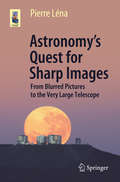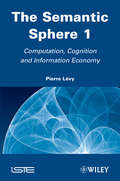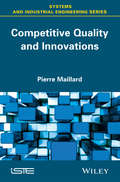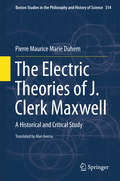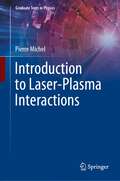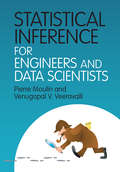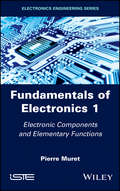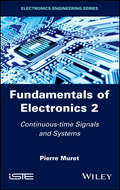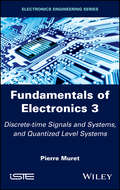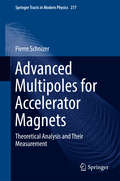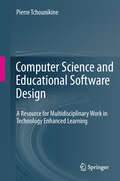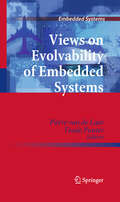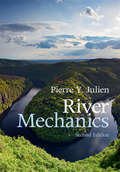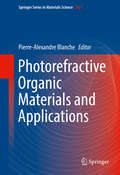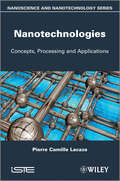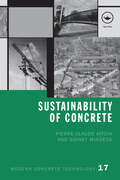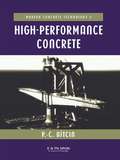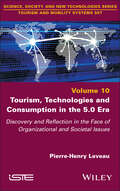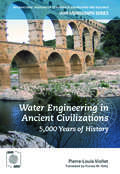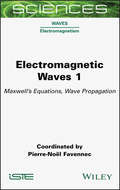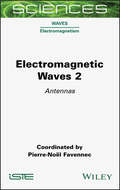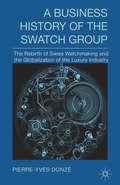- Table View
- List View
Astronomy’s Quest for Sharp Images: From Blurred Pictures to the Very Large Telescope (Astronomers' Universe)
by Pierre LénaSince the 1960s, astrophysical discoveries have blossomed, due to the emergence of powerful and new observational tools. Among them, a fantastic improvement of the sharpness of astronomical images, obtained with ground based optical telescopes, has been the result of two revolutions: adaptive optics and optical interferometry. Written for a general audience, interwoven with fascinating details about the evolution of vision and optics, this book tells a personal story of these revolutions in observational astronomy, born two centuries ago and blossoming in the past fifty years. With the construction of the Very Large Telescope in Chile, Europe played a leading role where young scientists, joining creative astronomers and engineers, have developed a superb creativity. Today, incredibly sharp images of exoplanetary systems and black hole environments are obtained and reveal new questions about Earth-like objects or fundamental physics. The author has been one of the actors of this adventure. His first-hand testimony is opening the future to new horizons.
The Semantic Sphere 1: Computation, Cognition and Information Economy
by Pierre LévyThe new digital media offers us an unprecedented memory capacity, an ubiquitous communication channel and a growing computing power. How can we exploit this medium to augment our personal and social cognitive processes at the service of human development? Combining a deep knowledge of humanities and social sciences as well as a real familiarity with computer science issues, this book explains the collaborative construction of a global hypercortex coordinated by a computable metalanguage. By recognizing fully the symbolic and social nature of human cognition, we could transform our current opaque global brain into a reflexive collective intelligence.
Competitive Quality and Innovation
by Pierre MaillardAll industrialized countries are stepping up efforts to revive economic activity through innovation. They use innovation to find solutions to the problems of the Company, and to operate as soon as possible the results of scientific research which represent an important source of competitive growth. The fundamental problems of our Company is focused on environmental protection, energy saving and searching for better use of renewable energy, recycling of raw materials, management of migration caused by social imbalances -economic and performance information and transportation, the growth of the human population, and the aging of the population means. For example, without therapeutic innovations life of the human being would not be much longer. Without technological innovation, transportation would not have been as reliable, fast and comfortable. Without technological innovation, the number and diversity of products would not have reached its current level. Innovation accelerates change and we use innovation to control the acceleration or use it. But, against paradoxically destabilizing innovation and the consumer gets used and often expected innovation. There is less and less attracted by innovation, and must fit into systems increasingly complex. The risks of failure are therefore increasingly large. The finding of this new economic dynamic, highlights the need to introduce quality initiatives in the innovation process to increase the chances of success for companies that want to grow through innovation. This book presents the key benchmarks that characterize these new practices of quality in the processes of innovation.
The Electric Theories of J. Clerk Maxwell
by Pierre Maurice Marie DuhemIn this volume Pierre Duhem first gives an overview of 19th century electricity and magnetism. Next, he applies his keen historical, philosophical, and physical intuition to critiquing Maxwell's theories, especially his electromagnetic theory of light and the ad hoc introduction of displacement current, which he considers too much a product of the "esprit de géométrie" than the "esprit de finesse," as Pascal calls it. In this book, Duhem is guided by the principle that a theory that offers contradictions, even if the theory is posed by a genius, needs to be analysed and discussed until a clear distinction can be made between the propositions likely to be logically demonstrated and statements that offend logic and which must be transformed or rejected. Furthermore, Duhem felt, in criticizing such a theory one must guard against narrowness of mind and petty corrections which would make one forget the merit of the inventor; and, more importantly, one must guard against the blind superstition which, for admiration of the author, would hide the serious defects of the work. He is not so great a genius that he surpasses the laws of reason. Pierre Duhem (1861-1916), chairman of theoretical physics at Bordeaux in 1984-1916, is well-known for his works in the history and philosophy of science.
Introduction to Laser-Plasma Interactions (Graduate Texts in Physics)
by Pierre MichelThis textbook provides a comprehensive introduction to the physics of laser-plasma interactions (LPI), based on a graduate course taught by the author. The emphasis is on high-energy-density physics (HEDP) and inertial confinement fusion (ICF), with a comprehensive description of the propagation, absorption, nonlinear effects and parametric instabilities of high energy lasers in plasmas.The recent demonstration of a burning plasma on the verge of nuclear fusion ignition at the National Ignition Facility in Livermore, California, has marked the beginning of a new era of ICF and fusion research. These new developments make LPI more relevant than ever, and the resulting influx of new scientists necessitates new pedagogical material on the subject. In contrast to the classical textbooks on LPI, this book provides a complete description of all wave-coupling instabilities in unmagnetized plasmas in the kinetic as well as fluid pictures, and includes a comprehensive description of the optical smoothing techniques used on high-power lasers and their impact on laser-plasma instabilities. It summarizes all the key developments from the 1970s to the present day in view of the current state of LPI and ICF research; it provides a derivation of the key LPI metrics and formulas from first principles, and connects the theory to experimental observables.With exercises and plenty of illustrations, this book is ideal as a textbook for a course on laser-plasma interactions or as a supplementary text for graduate introductory plasma physics course. Students and researchers will also find it to be an invaluable reference and self-study resource.
Statistical Inference for Engineers and Data Scientists
by Pierre Moulin Venugopal VeeravalliThis book is a mathematically accessible and up-to-date introduction to the tools needed to address modern inference problems in engineering and data science, ideal for graduate students taking courses on statistical inference and detection and estimation, and an invaluable reference for researchers and professionals. With a wealth of illustrations and examples to explain the key features of the theory and to connect with real-world applications, additional material to explore more advanced concepts, and numerous end-of-chapter problems to test the reader's knowledge, this textbook is the 'go-to' guide for learning about the core principles of statistical inference and its application in engineering and data science. The password-protected solutions manual and the image gallery from the book are available online.
Fundamentals of Electronics 1: Electronic Components and Elementary Functions
by Pierre MuretElectronics has undergone important and rapid developments over the last 60 years, which have generated a large range of theoretical and practical notions. This book presents a comprehensive treatise of the evolution of electronics for the reader to grasp both fundamental concepts and the associated practical applications through examples and exercises. This first volume of the Fundamentals of Electronics series comprises four chapters devoted to elementary devices, i.e. diodes, bipolar junction transistors and related devices, field effect transistors and amplifiers, their electrical models and the basic functions they can achieve. Volumes to come will deal with systems in the continuous time regime, the various aspects of sampling signals and systems using analog (A) and digital (D) treatments, quantized level systems, as well as DA and AD converter principles and realizations.
Fundamentals of Electronics 2: Continuous-time Signals and Systems
by Pierre MuretThis book presents a synthesis of Electronics through keynotes which are substantiated in three volumes. The first one comprises four chapters devoted to elementary devices, i.e. diodes, bipolar transistors and related devices, field effect transistors and amplifiers. In each of one, device physics, non linear and linearized models, and applications are studied. The second volume is devoted to systems in the continuous time regime and contains two chapters: one describes different approaches to the transfer function concept and applications, and the following deals with the quadripole properties, filtering and filter synthesis. The third volume presents the various aspects of sampling systems and quantized level systems in the two last chapters.
Fundamentals of Electronics 3: Discrete-time Signals and Systems, and Quantized Level Systems
by Pierre MuretFundamentals of Electronics 3: Discrete-time Signals and Systems, and Quantized Level Systems by Pierre Muret
Advanced Multipoles for Accelerator Magnets: Theoretical Analysis and Their Measurement (Springer Tracts in Modern Physics #277)
by Pierre SchnizerThis monograph presents research on the transversal beam dynamics of accelerators and evaluates and describes the respective magnetic field homogeneity. The widely used cylindrical circular multipoles have disadvantages for elliptical apertures or curved trajectories, and the book also introduces new types of advanced multipole magnets, detailing their application, as well as the numerical data and measurements obtained. The research presented here provides more precise descriptions of the field and better estimates of the beam dynamics. Moreover, the effects of field inhomogeneity can be estimated with higher precision than before. These findings are further elaborated to demonstrate their usefulness for real magnets and accelerator set ups, showing their advantages over cylindrical circular multipoles. The research findings are complemented with data obtained from the new superconducting beam guiding magnet models (SIS100) for the FAIR (Facility for Antiproton and Ion Research) project. Lastly, the book offers a comprehensive survey of error propagation in multipole measurements and an appendix with Mathematica scripts to calculate advanced magnetic coil designs.
Computer Science and Educational Software Design: A Resource for Multidisciplinary Work in Technology Enhanced Learning
by Pierre TchounikineDeveloping educational software requires thinking, problematizing, representing, modeling, implementing and analyzing pedagogical objectives and issues, as well as conceptual models and software architectures. Computer scientists face the difficulty of understanding the particular issues and phenomena to be taken into account in educational software projects and of avoiding a naïve technocentered perspective. On the other hand, actors with backgrounds in human or social sciences face the difficulty of understanding software design and implementation issues, and how computer scientists engage in these tasks. Tchounikine argues that these difficulties cannot be solved by building a kind of "general theory" or "general engineering methodology" to be adopted by all actors for all projects: educational software projects may correspond to very different realities, and may be conducted within very different perspectives and with very different matters of concern. Thus the issue of understanding each others' perspectives and elaborating some common ground is to be considered in context, within the considered project or perspective. To this end, he provides the reader with a framework and means for actively taking into account the relationships between pedagogical settings and software, and for working together in a multidisciplinary way to develop educational software. His book is for actors engaged in research or development projects which require inventing, designing, adapting, implementing or analyzing educational software. The core audience is Master's and PhD students, researchers and engineers from computer science or human and social sciences (e.g., education, psychology, pedagogy, philosophy, communications or sociology) interested in the issues raised by educational software design and analysis and in the variety of perspectives that may be adopted.
Views on Evolvability of Embedded Systems
by Pierre Van de Laar Teade PunterEvolvability, the ability to respond effectively to change, represents a major challenge to today's high-end embedded systems, such as those developed in the medical domain by Philips Healthcare. These systems are typically developed by multi-disciplinary teams, located around the world, and are in constant need of upgrading to provide new advanced features, to deal with obsolescence, and to exploit emerging enabling technologies. Despite the importance of evolvability for these types of systems, the field has received scant attention from the scientific and engineering communities. Views on Evolvability of Embedded Systems focuses on the topic of evolvability of embedded systems from an applied scientific perspective. In particular, the book describes results from the Darwin project that researched evolvability in the context of Magnetic Resonance Imaging (MRI) systems. This project applied the Industry-as-Laboratory paradigm, in which industry and academia join forces to ensure continuous knowledge and technology transfer during the project's lifetime. The Darwin project was a collaboration between the Embedded Systems Institute, the MRI business unit of Philips Healthcare, Philips Research, and five Dutch universities. Evolvability was addressed from a system engineering perspective by a number of researchers from different disciplines such as software-, electrical- and mechanical engineering, with a clear focus on economic decision making. The research focused on four areas: data mining, reference architectures, mechanisms and patterns for evolvability, in particular visualization & modelling, and economic decision making. Views on Evolvability of Embedded Systems is targeted at both researchers and practitioners; they will not only find a state-of-the-art overview on evolvability research, but also guidelines to make systems more evolvable and new industrially-validated techniques to improve the evolvability of embedded systems.
River Mechanics (2nd Edition)
by Pierre Y. JulienThe second edition of Julien's textbook presents an analysis of rivers from mountain streams to river estuaries. The book is rooted in fundamental principles to promote sound engineering practice. <P><P>State-of-the-art methods are presented to underline theory and engineering applications. River mechanics blends the dual concepts of water conveyance and sediment transport. Like the first edition, this textbook contains ample details on river equilibrium, river dynamics, bank stabilization, and river engineering. Complementary chapters also cover the physical and mathematical modeling of rivers. As well as being completely updated throughout, three new chapters have been added on watershed dynamics, hillslope stability, and stream restoration. Throughout the text, hundreds of examples, exercises, problems, and case studies assist the reader in learning the essential concepts of river engineering. The textbook is very well illustrated to enhance advanced student learning, while researchers and practitioners will find the book to be an invaluable reference.<P> Presents a detailed analysis of rivers from the mountains to the oceans: readers will benefit from an integrated view of rivers rather than a fragmented stream versus rivers approach,<P> Numerous worked examples, data sets, exercises, and solved problems will help advanced students and researchers in their understanding of river mechanics,<P> The second edition has been brought completely up-to-date, with new sections on hillslope stability, river meandering, and stream restoration, providing readers with a broader base for the analysis of rivers and environmental considerations,.
Photorefractive Organic Materials and Applications
by Pierre-Alexandre BlancheThis book provides comprehensive, state-of-the art coverage of photorefractive organic compounds, a class of material with the ability to change their index of refraction upon illumination. The change is both dynamic and reversible. Dynamic because no external processing is required for the index modulation to be revealed, and reversible because the index change can be modified or suppressed by altering the illumination pattern. These properties make photorefractive materials very attractive candidates for many applications such as image restoration, correlation, beam conjugation, non-destructive testing, data storage, imaging through scattering media, holographic imaging and display. The field of photorefractive organic material is also closely related to organic photovoltaic and light emitting diode (OLED), which makes new discoveries in one field applicable to others.
Nanotechnologies: Concepts, Production and Applications
by Pierre-Camille LacazeNanotechnologies: Concepts, Processing and Applications describes and explains how nanotechnologies have entered our everyday lives through scientific and industrial applications with the emphasis placed on the new perspectives in various fields related to societal problems. This book details how successive discoveries of new nanocarbon structures along with progress in different microscopy techniques have caused nanomaterials to take on an increasingly important role in electronics, electrochemical energy storage – batteries and fuel cells – and the electrical conversion of solar energy. Views once seen as futuristic on nanomachines and nanorobotics, therapeutic hopes and medical advances – such as those resulting from the application of new in-situ drug-delivery nanotechniques – are all presented. The most innovative developments are analyzed in terms of applications and should enable the reader to form his or her own opinion about the reality of the progress that can be expected from nanotechnologies in the near future. The book offers background reading for teachers in colleges who wish to have an overview on this subject.
Binders for Durable and Sustainable Concrete (Modern Concrete Technology)
by Pierre-Claude AitcinLinking theory to practice, this book provides a better fundamental understanding of Portland cement and hydraulic binders which is necessary to make better concrete. It has been clearly demonstrated that concrete durability is closely linked to its water/binder ratio and proper curing during the first week after casting. In this rigorously present
Sustainability of Concrete (Modern Concrete Technology)
by Sidney Mindess Pierre-Claude AitcinProduction of Portland cement is responsible for about seven percent of the world's greenhouse gas emissions. The pressure to make the production of concrete more sustainable, or "greener", is considerable and increasing. This requires a wholesale shift in processes, materials and methods in the concrete industry. Pure Portland cement will nee
High Performance Concrete
by Pierre-Claude AïtcinA complete review of the fast-developing topic of high performance concrete (HPC) by one of the leading researchers in the field. It covers all aspects of HPC from materials, properties and technology, to construction and testing. The book will be valuable for all concrete technologists and construction engineers wishing to take advantage of the re
Reconfigurable Logic: Architecture, Tools, and Applications (Devices, Circuits, and Systems)
by Pierre-Emmanuel GaillardonDuring the last three decades, reconfigurable logic has been growing steadily and can now be found in many different fields. Field programmable gate arrays (FPGAs) are one of the most famous architecture families of reconfigurable devices. FPGAs can be seen as arrays of logic units that can be reconfigured to realize any digital systems. Their high versatility has enabled designers to drastically reduce time to market, and made FPGAs suitable for prototyping or small production series in many branches of industrial products. In addition, and thanks to innovations at the architecture level, FPGAs are now conquering segments of mass markets such as mobile communications.Reconfigurable Logic: Architecture, Tools, and Applications offers a snapshot of the state of the art of reconfigurable logic systems. Covering a broad range of architectures, tools, and applications, this book: Explores classical FPGA architectures and their supporting tools Evaluates recent proposals related to FPGA architectures, including the use of network-on-chips (NoCs) Examines reconfigurable processors that merge concepts borrowed from the reconfigurable domain into processor design Exploits FPGAs for high-performance systems, efficient error correction codes, and high-bandwidth network routers with built-in security Expounds on emerging technologies to enhance FPGA architectures, improve routing structures, and create non-volatile configuration flip-flops Reconfigurable Logic: Architecture, Tools, and Applications reviews current trends in reconfigurable platforms, providing valuable insight into the future potential of reconfigurable systems.
Tourism, Technologies and Consumption in the 5.0 Era: Discovery and Reflection in the Face of Organizational and Societal Issues (ISTE Invoiced)
by Pierre-Henry LeveauHistory shows us that technologies help humankind in our daily activities. Every major technological evolution brings about an economic, cultural and social revolution, transforming the lifestyles of citizens, professional organizations and consumer practices. Digital technologies are a perfect illustration of this, and tourism is no exception. Soon, the technologies of the "X.0" generation (AI, cobots, biotechnologies, etc.) will herald a new socio-technological revolution, ushering in the 5.0 era. Tourism, Technologies and Consumption in the 5.0 Era explores the role and challenges of new technologies in “Society 5.0”, which is gradually transforming the practices of both tourism professionals and travelers. Faced with the challenges of climate change and sustainable development, it examines the opportunities and limits of bionumeric technologies for more sustainable and responsible tourism. This book helps us decipher a world in transition, where digital technologies will reinvent consumer experiences, particularly in tourism, and encourage more socially responsible behavior.
Water Engineering inAncient Civilizations: 5,000 Years of History (IAHR Monographs)
by Pierre-Louis ViolletThis new book offers an engineer's perspective on the history of water technology and its impact on the development of civilisation. A Second Edition and translation into English of the French book "L'Hydraulique dans les Civilisations Anciennes".Water professionals, engineers, scientists, and students will find this book fascinating and invaluable
Electromagnetic Waves 1: Maxwell's Equations, Wave Propagation
by Pierre-Noël FavennecElectromagnetic Waves 1 examines Maxwell’s equations and wave propagation. It presents the scientific bases necessary for any application using electromagnetic fields, and analyzes Maxwell’s equations, their meaning and their resolution for various situations and material environments. These equations are essential for understanding electromagnetism and its derived fields, such as radioelectricity, photonics, geolocation, measurement, telecommunications, medical imaging and radio astronomy. This book also deals with the propagation of electromagnetic, radio and optical waves, and analyzes the complex factors that must be taken into account in order to understand the problems of propagation in a free and confined space. Electromagnetic Waves 1 is a collaborative work, completed only with the invaluable contributions of Ibrahima Sakho, Hervé Sizun and JeanPierre Blot, not to mention the editor, Pierre-Noël Favennec. Aimed at students and engineers, this book provides essential theoretical support for the design and deployment of wireless radio and optical communication systems.
Electromagnetic Waves 2: Antennas
by Pierre-Noël FavennecElectromagnetic Waves 2 examines antennas in the field of radio waves. It analyzes the conditions of use and the parameters that are necessary in order to create an effective antenna. This book presents antennas’ definitions, regulations and fundamental equations, and describes the various forms of antennas that can be used in radio: horns, waveguides, coaxial cables, printed and miniature antennas. It presents the characterization methods and the link budgets as well as the digital methods that make the fine calculation of radio antennas possible. Electromagnetic Waves 2 is a collaborative work, completed only with the invaluable contributions of Ibrahima Sakho, Hervé Sizun and JeanPierre Blot, not to mention the editor, Pierre-Noël Favennec. Aimed at students and engineers, this book provides essential theoretical support for the design and deployment of wireless radio and optical communication systems.
A Business History of the Swatch Group: The Rebirth of Swiss Watchmaking and the Globalization of the Luxury Industry
by Pierre-Yves DonzéThis book offers a detailed and full analysis of the strategy which enabled the Swatch Group to establish itself on the world market. In particular, it tackles the issues of production restructuring, with the opening of subsidiaries in Asia, and the implementation of a new marketing strategy, characterized by the move towards luxury.
The Formation of the Swiss Hospital System (1840–1960): An Analysis of Surgeon-Modernisers in the Canton of Vaud
by Pierre-Yves DonzéThis book offers an analysis of the formation of contemporary hospital systems between the mid-19th century and the mid-20th century. Based on extensive archival material and a broad international literature review, it focuses on the case of the canton of Vaud, Switzerland, and uses a triple approach that discusses technological innovations, hospital management, and health policy. This research is a major contribution to the history of medicine which gives a unique overview of the formation of contemporary hospital systems.
